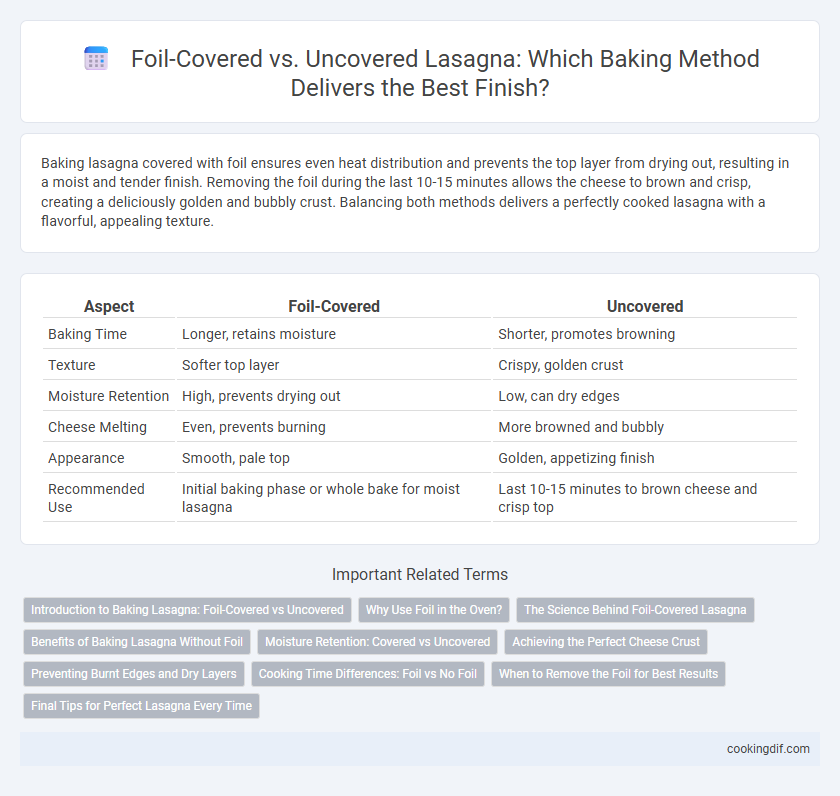Baking lasagna covered with foil ensures even heat distribution and prevents the top layer from drying out, resulting in a moist and tender finish. Removing the foil during the last 10-15 minutes allows the cheese to brown and crisp, creating a deliciously golden and bubbly crust. Balancing both methods delivers a perfectly cooked lasagna with a flavorful, appealing texture.
Table of Comparison
| Aspect | Foil-Covered | Uncovered |
|---|---|---|
| Baking Time | Longer, retains moisture | Shorter, promotes browning |
| Texture | Softer top layer | Crispy, golden crust |
| Moisture Retention | High, prevents drying out | Low, can dry edges |
| Cheese Melting | Even, prevents burning | More browned and bubbly |
| Appearance | Smooth, pale top | Golden, appetizing finish |
| Recommended Use | Initial baking phase or whole bake for moist lasagna | Last 10-15 minutes to brown cheese and crisp top |
Introduction to Baking Lasagna: Foil-Covered vs Uncovered
Baking lasagna covered with foil traps moisture, ensuring evenly cooked noodles and preventing the top layer from drying out or burning. Uncovered baking allows the cheese and sauce on top to brown and develop a crispy, caramelized texture, enhancing flavor and presentation. For optimal results, many chefs recommend starting with foil-covered baking for moisture retention, followed by uncovered baking to achieve a golden, bubbly finish.
Why Use Foil in the Oven?
Covering lasagna with foil during baking helps retain moisture, ensuring the pasta layers remain tender and the cheese melts evenly without over-browning. Uncovered baking encourages a crispy, golden top layer but risks drying out the interior if left too long. Using foil balances heat distribution and prevents excessive moisture loss, crucial for a perfectly cooked, creamy lasagna.
The Science Behind Foil-Covered Lasagna
Foil-covered lasagna retains moisture by trapping steam, preventing the pasta and cheese from drying out during baking. This protective barrier ensures even heat distribution, allowing the ingredients to cook thoroughly while maintaining a tender texture. Removing the foil towards the end of baking promotes browning and creates a crispy, golden top layer through Maillard reaction and caramelization.
Benefits of Baking Lasagna Without Foil
Baking lasagna uncovered allows the top layer of cheese and sauce to brown and develop a crispy, caramelized texture that enhances flavor and visual appeal. This method promotes moisture evaporation, preventing sogginess and creating a balanced, slightly crunchy crust. Leaving the foil off also encourages even heat distribution, ensuring thorough cooking and a perfectly set, rich lasagna.
Moisture Retention: Covered vs Uncovered
Foil-covered lasagna retains moisture effectively by trapping steam, resulting in a tender and evenly cooked dish. Baking uncovered allows the top layer to brown and crisp, but can lead to moisture loss and a drier texture. For optimal moisture retention, cover with foil during most of the baking time, then uncover briefly to achieve a golden finish.
Achieving the Perfect Cheese Crust
Covering lasagna with foil during baking traps moisture, ensuring tender layers but preventing the cheese from browning properly. Removing the foil in the last 10-15 minutes promotes a golden, crispy cheese crust by allowing direct heat to caramelize the cheese's surface. For the perfect balance, start covered to cook evenly and finish uncovered to achieve that desirable, bubbly, browned cheese topping.
Preventing Burnt Edges and Dry Layers
Covering lasagna with foil during baking helps prevent burnt edges by retaining moisture and providing even heat distribution, which keeps pasta layers tender and prevents drying. Uncovered baking allows the top layer to brown and crisp, but risks dry layers and burnt edges if not monitored carefully. For optimal results, start with foil-covered baking to lock in moisture and remove the foil in the last 10-15 minutes to achieve a golden, bubbly finish.
Cooking Time Differences: Foil vs No Foil
Covering lasagna with foil during baking helps retain moisture, resulting in a tender texture and usually requires a longer cooking time, typically around 45-60 minutes at 375degF (190degC). Baking uncovered allows the top to brown and crisp but may dry out the edges faster, often reducing the cooking time by about 10-15 minutes. Adjusting oven temperature and checking for bubbling cheese and heated-through layers ensures optimal results regardless of foil use.
When to Remove the Foil for Best Results
Removing the foil during the last 15-20 minutes of lasagna baking allows the top layer of cheese to brown and develop a crispy texture without drying out the rest of the dish. Keeping the foil on for the majority of the baking time ensures even heat distribution and prevents excessive moisture loss, which helps the noodles cook thoroughly and the sauce to meld perfectly. To achieve the ideal balance between a moist interior and a golden, bubbly crust, remove the foil once the lasagna is heated through and bubbling around the edges.
Final Tips for Perfect Lasagna Every Time
Covering lasagna with foil during baking retains moisture, ensuring tender pasta layers and preventing the cheese from drying out. Removing the foil in the last 10-15 minutes promotes a golden, bubbly cheese crust and caramelized edges. For perfect lasagna every time, balance covered and uncovered baking to achieve a moist interior with a crispy, flavorful finish.
Foil-covered vs uncovered for baking finish Infographic

 cookingdif.com
cookingdif.com